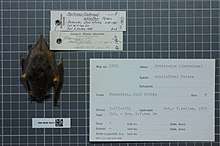Schlieffen's bat
Schlieffen's bat or Schlieffen's twilight bat (Nycticeinops schlieffeni) is a species of vesper bat found in Africa. It has been placed in numerous genera since its first description in 1859, but morphological and genetic studies have confirmed it as the only species in the genus Nycticeinops.[2][3] It is named for the collector of the original specimen, Wilhelm von Schlieffen-Schlieffiennburg.[4]
| Schlieffen's bat | |
|---|---|
 | |
| Scientific classification | |
| Kingdom: | Animalia |
| Phylum: | Chordata |
| Class: | Mammalia |
| Order: | Chiroptera |
| Family: | Vespertilionidae |
| Genus: | Nycticeinops Hill and Harrison, 1987 |
| Species: | N. schlieffeni |
| Binomial name | |
| Nycticeinops schlieffeni Peters, 1859 | |
| Synonyms | |
|
Nycticeius schlieffeni (Peters, 1859) | |
Description
Schlieffen's bat is an unusually small bat, measuring 4 to 5 centimetres (1.6 to 2.0 in) in head-body length, and weighing only 3.7 to 5 grams (0.13 to 0.18 oz). Although there is some variation on coat colour across its range, in general, the bat is brown with pale grey or white underparts. It has a broad, flattened skull, with a short, wide, sparsely haired snout. The ears are rounded, with a blunt, convex, tragus. There is a prominent calcar extending about half the way along the uropatagial border, and a proportionately long tail of approximately 3 centimetres (1.2 in).[4]
In many respects, Schlieffen's bats resemble the more familiar evening bats of North America; they can most readily be distinguished by the shorter snout, and by the detailed shape of the baculum.[4]
Distribution and subspecies
Schlieffen's bat is found widely across Africa outside the equatorial rainforest. It inhabits a broad band of territory from Mauritania and Senegal in the west across to Namibia, South Africa, Angola and Mozambique in Southern Africa, to Kenya and Tanzania in the African Great Lakes region, to Ethiopia, Somalia, Djibouti and Eritrea in the Horn of Africa, to Sudan and Egypt in the Nile Valley. It is also found in the south-western Arabian peninsula.[4]
Several subspecies of Schlieffen's bat have been identified. However, there has been little agreement on their status or range. The most recent analysis, as reported in the 2005 edition of Mammal Species of the World, concluded that there is insufficient evidence for the retention of any of these subspecies, and Schlieffen's bat should therefore be considered monotypic.[5]
Behaviour and biology
Schlieffen's bats forage over fresh water, such as marshes, rivers, and lakes, and are found in a wide range of riparian forest and savannah environments. Like many bats, they are nocturnal, and they spend the day roosting in crevices in rocks and trees, and may take up residence in man-made buildings or cellars. They appear to be generally solitary, but may roost in small groups of three or so individuals.[4]
The echolocation calls of Schlieffen's bats have been reported to be narrow band with steep frequency modulation, and to range from 39 to 47 kHz. They feed primarily on beetles and caddisflies, and a smaller proportion of moths, bugs, and flies.[6] Their predators are known to include bat hawks.[7]
Schlieffen's bats mate in June, but carry the sperm in their uterus until August, when ovulation and fertilisation occur.[8] They typically give birth to a litter of three young.[9]
References
- Jacobs, D.; Cotterill, F.P.D.; Taylor, P.J. & Monadjem, A. (2008). "Nycticeinops schlieffeni". IUCN Red List of Threatened Species. 2008. Retrieved 14 Jul 2012.CS1 maint: ref=harv (link)
- Hill, J.E. & Harrison, D.L. (1987). "The baculum in the Vespertilioninae (Chiroptera: Vespertilioninae) with a systematic review. A synopsis of Pipistrellus and Eptesicus, and the descriptions of a new genus and subgenus". Bulletin of the British Museum (Natural History), Zoology. 52 (7): 225–305.
- Ruedas, L.A.; et al. (1990). "Chromosomes of five species of vespertilionid bats from Africa". Journal of Mammalogy. 71 (1): 94–100. doi:10.2307/1381324. JSTOR 1381324.
- Johnston, D.S. (2006). "Nycticeinops schlieffeni". Mammalian Species. 798: Number 798: pp. 1–4. doi:10.1644/798.1.
- Wilson, D.E.; Reeder, D.M., eds. (2005). Mammal Species of the World: A Taxonomic and Geographic Reference (3rd ed.). Johns Hopkins University Press. ISBN 978-0-8018-8221-0. OCLC 62265494.
- Fenton, M.B. & Thomas, M.W. (1980). "Dry-season overlap in activity patterns, habitat use and prey selection by sympatric African insectivorous bats". Biotropica. 12 (2): 81–90. doi:10.2307/2387723. JSTOR 2387723.
- Fenton, M.B.; et al. (1977). "Activity patterns, habitat use, and prey selection by some African insectivorous bats". Biotropica. 9 (2): 73–85. doi:10.2307/2387662. JSTOR 2387662.
- van der Merwe, M. & Rautenbach, I.L. (1987). "Reproduction in Schlieffen's bat, Nycticeius schlieffenii, in the eastern Transvaal lowveld, South Africa". Journal of Reproduction and Fertility. 81 (1): 41–50. doi:10.1530/jrf.0.0810041. PMID 3668959.
- van der Merwe, M. & Rautenbach, I.L. (1986). "Multiple births in Schlieffen's bat, Nycticeius schlieffenii (Peters, 1859) (Chiroptera: Vespertilionidae) from the southern African subregion". 1986. 21 (1): 48–50.
